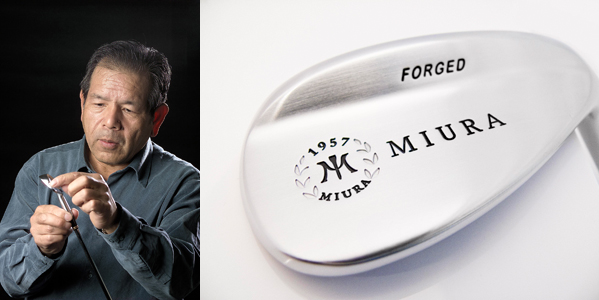Oh My! Miura

Miura Golf, with its North American headquarters in Vancouver, BC, has quietly become one of the finest clubmakers in the business
by Tony Dear
True connoisseurs of golf equipment know Miura makes what are reputed to be the finest forged irons in the game. They have no doubt tried them and been instantly seduced not only by the look of the club but also the exquisite feedback from a shot well hit.
The less informed might have seen the Miura logo at some point in their life and are vaguely aware the Japanese manufacturer does not design clubs for the likes of them.
Miura irons, you understand, are more than a bit special. Built in Japan in limited quantities, they are not inexpensive either and have a reputation for being suitable only for “players.” It’s not a reputation the company disputes.
Each club is a work of art, science, devotion and skill, and created from soft 1025 carbon-steel using a 14-step forging process conceived by Katsuhiro Miura who grew up in the Japanese city of Himeji where master craftsmen once built swords for Samurai warriors.
Miura began forging club heads at the age of 16. At 23 he set up his own manufacturing company which, 45 years later, still adheres to the same basic principle – that quality is everything.
Precision is a big deal at Miura. The company’s forging process is similar to that of other company’s but differs in one crucial area. After the cylindrical steel billet has been heated to 1200¢ªC, it is fashioned into the shape of the clubhead but without a hosel. Most first forgings incorporate the hosel, but Miura believed this was a significant flaw that ultimately had a negative effect on the molecular structure of the steel.
“Mr. Miura believed the hosel should be made separately from the clubhead and needed to be heated and hammered differently to how the face was treated,” says Bill Holowaty, the company’s Vice-President of General Operations who is based in Vancouver, BC. “By making it separately, we are able to treat the face without compromising the quality of the hosel and vice versa.”
The marriage of hosel to head doesn’t happen in a Miura clubhead until the sixth stage of the forging process when it is attached using the company’s proprietary spin-welding process. Thereafter, expert grinders make tiny but essential adjustments to the head’s weight and finish – it is polished in a vast polishing barrel, chrome-plated, sand-blasted and finally decorated.
The resulting clubheads are so uniform they have a weight error of plus or minus 0.5g, a standard which, Miura claims, cannot be matched by any other golf club manufacturer.
And because only 500 or so are made during a typical day by 34 skilled technicians on the factory floor, there is never, Holowaty repeats never, a risk that quality may be compromised.
“One of the factory employees may have a tray of 50 clubheads,” adds Holowaty who spent a few years in Japan as a professional hockey player. “Only when he is convinced all 50 meet very specific standards will he move them on to the next stage in the process.”
Though the consistency from one head to the next is impressive, it is far from the only benefit derived from Mr. Miura’s magnificent molecule-manipulating method. By influencing the stability of the steel’s grain structure early in the process, Miura forgings not only feel pleasantly soft they also optimize energy flow from clubhead to ball which increases ball speed.
That is critical, for now not only can forged clubs look and feel superior to investment cast models – always the forged iron’s raison d’être – they can also perform better too, to previous forged irons at least. “We welcome the introduction of launch monitors and the use of robots,” says Holowaty, “because they demonstrate that, beyond what we already knew about the look and feel of our clubs, they also achieve better results than forged irons used to.”
Miura believes the new woods in his “Precious Edition” series also produce better results. The driver features a slightly progressed 390cc head which, Holowaty says, is the size that best enables golfers to return the head to square at impact. “The size isn’t a compromise between looks and performance,” he points out. “We think it’s the optimal size as clubheads that are significantly bigger tend to create too much drag.”
Starting this year, Miura intends marketing its products a little more aggressively than in years past when it relied on a select number of green grass sites to create awareness. The focus will be on the company’s attention to detail, innovation and craftsmanship though Miura himself seems unconcerned by the success or failure of marketing programs.
“The good golfer will always find me,” he says.
But if indeed what Holowaty says about the irons’ performance is true and enough people get to hear it, then Miura clubs could see, if not a surge exactly, then definitely a boost in sales this year. Some devotees around the world may have to wait for their clubs, however, as Holowaty estimates the foundry can produce only 20,000 sets a year.
“We are a relatively small family-run business,” he says. “Mr. Miura’s two sons, Yoshitaka and Shinei, are master clubmakers themselves and work with their father, and if you visited the foundry you’d probably see Mrs. Miura painting or inspecting clubheads. But it’s not so much about the size of the foundry or the staff. We wouldn’t really want to make more than 20,000 because at some point you’d start compromising quality.”
And, as we know, Miura would never do that.





